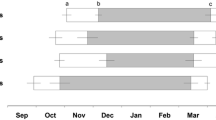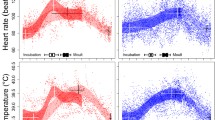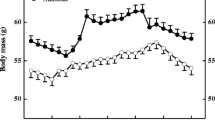Abstract
The jerboa (Jaculus orientalis) has been described in the past as a hibernator, but no reliable data exist on the daily and seasonal rhythmicity of body temperature (T b). In this study, T b patterns were determined in different groups of jerboas (isolated males and females, castrated males and grouped animals) maintained in captivity during autumn and winter, and submitted to natural variations of light and ambient temperature (T a). T b and T a variations were recorded with surgically implanted iButton temperature loggers at 30-min intervals for two consecutive years. About half (6/13) of isolated female jerboas hibernated with a T b < 33°C, with hibernation bouts interspersed with short periods of normothermy from November to February. Hibernation bout durations were longer (4–5 days) than those of normothermia phases (1–4 days). During hibernation, the minimum T b was low (T bmin ~10.7°C). In contrast, one of the 12 isolated males showed short hibernation bouts of ca. 2 days late in the hibernation season, February–March. The males had T bmin values of 15.1°C. In contrast to predictions, no castrated males hibernated. When jerboas were grouped, females and males exhibited concomitant torpor bouts. In males, the longest bouts were observed during the late hibernation season. These data suggest complex regulation of hibernation in jerboas.








Similar content being viewed by others
References
Arnold W (1988) Social thermoregulation during hibernation in alpine marmots (Marmota marmota). J Comp Physiol B 158:51–56
Barnes BM, Ritter D (1993) Pattern of body temperature change in hibernating arctic ground squirrels. In: Carey C, Florant GL, Wunder BAl, Horwitz B (eds) Life in the cold: ecological, physiological and molecular mechanisms. Westview Press, Boulder, pp 119–130
Boissin J, Canguilhem B (1998) Les rythmes du vivant. Origine et contrôle des rythmes biologiques. Nathan Universités, Editions du CNRS, Paris
Brown LN (1967) Seasonal activity patterns and breeding of the western jumping mouse (Zapus princeps) in Wyoming. Am Midl Nat 78:460–470
Buijs RM, Pévet P, Masson-Pévet M, Pool CW, de Vries GJ, Canguilhem B, Vivien-Roels B (1986) Seasonal variation in vasopressin innervation in the brain of the European hamster (Cricetus cricetus). Brain Res 371:193–196
Canguilhem B, Malan A, Masson-Pévet M, Nobelist P, Kirsch R, Pévet P, Le Minor J (1994) Search for rhythmicity during hibernation in the European hamster. J Comp Physiol B 163:690–698
Collins AR, Cameron DM (1984/5) The effects of diet and photoperiod on hibernation in the woodland jumping mouse Napaeozapus insignus. Can J Zool 62:1938–1945
Cranford JA (1978) Hibernation in the western jumping mouse (Zapus princeps). J Mammal 59:496–509
Cranford JA (1983) Body temperature, heart rate and oxygen consumption of normothermic and heterothermic western jumping mice (Zapus princeps). Comp Biochem Physiol 74A:595–599
El Hilali M, Veillat JP (1975) Jaculus orientalis: a true hibernator. Mammalia 39:402–404
El Kebbaj Z, Andreoletti P, Mountassif D, Kabine M, Schohn H, Dauça M, Latruffe N, El Kebbaj MS, Cherkaoui-Malki M (2009) Differential regulation of peroxisome proliferator-activated receptor (PPAR)-alpha1 and truncated PPARalpha2 as an adaptive response to fasting in the control of hepatic peroxisomal fatty acid beta-oxidation in the hibernating mammal. Endocrinology 150:1192–1201
El Ouezzani S, Tramu G, Magoul R (1999) Neuronal activity in the mediobasal hypothalamus of hibernating jerboas (Jaculus orientalis). Neurosci Lett 260:13–16
El Ouezzani S, Tramu G, Magoul R (2000) The GnRH neurosecretory system in the jerboa brain and its seasonal variations. J Neuroendocrinol 12:1205–1212
El Ouezzani S, Lafon P, Tramu G, Magoul R (2001) Neuropeptide Y gene expression in the jerboa arcuate nucleus: modulation by food deprivation and relationship with hibernation. Neurosci Lett 305:127–130
Geiser F (1988) Reduction of metabolism during hibernation and daily torpor in mammals and birds: temperature effect or physiological inhibition. J Comp Physiol 158:25–37
Geiser F (2004) Metabolic rate and body temperature reduction during hibernation and daily torpor. Ann Rev Physiol 66:239–274
Geiser F, Baudinette RV (1990) The relationship between body mass and rate of rewarming from hibernation and daily torpor in mammals. J Exp Biol 151:349–359
Geiser F, Ruf T (1995) Hibernation versus daily torpor in mammals and birds: physiological variables and classification of torpor patterns. Physiol Zool 68:935–966
Geiser F, Holloway JC, Körtner G (2007) Thermal biology, torpor and behaviour in sugar gliders: a laboratory-field comparison. J Comp Physiol B 177:495–501
Grigg G, Beard L (2000) Hibernation by echidnas in mild climates: Hints about the evolution of endothermy? In: Heldmaier G, Klingenspor M (eds) Life in the cold. Eleventh international hibernation symposium, Springer, pp 5–19
Heldmaier G, Ruf T (1992) Body temperature and metabolic rate during natural hypothermia in endotherms. J Comp Physiol B 162:696–706
Hermes ML, Buijs RM, Masson-Pévet M, Van der Woude T, Brenklé R, Kirsch R, Pévet P (1989) Central vasopressin infusion prevents hibernation in the European hamster (Cricetus cricetus L.). Proc Nat Acad Sci USA 86:6408–6411
Hermes ML, Buijs RM, Masson-Pévet M, Pévet P (1990) Seasonal changes in vasopressin in the brain of the garden dormouse (Eliomys quercinus L.). J Comp Neurol 293:340–346
Hermes ML, Kalsbeek A, Kirsch R, Buijs RM, Pévet P (1993) Induction of arousal in hibernating European hamster (Cricetus cricetus) by vasopressin infusion in the lateral septum. Brain Res 631:313–316
Hooper ET, EL Hilali M (1972) Temperature regulation and habits in two species of jerboa, genus Jaculus. J Mammal 37:105–121
Johansen K, Krog J (1959) Diurnal body temperature variations and hibernation in the birchmouse, Sicista betulina. Am J Physiol 196:1200–1204
Kabine M, El Kebbaj MS, Hafiani A, Latruffe N, Cherkaoui-Malki M (2003) Hibernation impact on the catalytic activities of the mitochondrial D-3-hydroxybutyrate dehydrogenase in liver and brain tissues of jerboa (Jaculus orientalis). BMC Biochem 10:4–111
Kart-Gür M, Refinetti R, Gür H (2009) Daily rhythmicity and hibernation in the Anatolian ground squirrel under natural and laboratory conditions. J Comp Physiol B 179:155–164
Kirmitz JP (1962) Jerboa as a desert species adaptation to desert environment. A study of the jerboa rat and man. Butterworths, London, pp 14–31
Körtner G, Geiser F (2000) The temporal organization of daily torpor and hibernation: circadian and circannual rhythms. Chronobiol Int 17:103–128
Lakhdar-Ghazal N, Dubois-Dauphin M, Hermes ML, Buijs RM, Bengelloun W, Pévet P (1995) Vasopressin in the brain of a desert hibernator, the jerboa (Jaculus orientalis): presence of sexual dimorphism and seasonal variation. J Comp Neurol 358:499–517
Lovegrove BG (2009) Modification and miniaturization of Thermochron iButtons for surgical implantation into small animals. J Comp Physiol B 179:451–458
Mouhoub-Sayah C, Robin JP, Malan A, Pévet P, Saboureau M (2008) Patterns of body temperature change in the Algerian hedgehog (Atelerix algirus) during autumn and winter. In: Lovegrove BG, McKechnie AE (eds) Hypometabolism in animals: hibernation torpor and cryobiology. University of KwaZulu-Natal, Pietermaritzburg, pp 307–316
Muchlinski AE (1980) Duration of hibernation bouts in Zapus hudsonius. Comp Biochem Physiol A 67:287–289
Mzilikazi N, Lovegrove BG (2002) Reproductive activity influences thermoregulation and torpor in the pouched mouse, Saccostomus campestris. J Comp Physiol B 172:7–16
Pévet P, Buijs RM, Masson-Pévet M (1987) Effect of pinealectomy and constant high level of circulating melatonin of 5-methoxytryptamine on the vasopressin innervations in the brain of the European hamster (Cricetus cricetus L.). J Neural Trans 70:287–294
Pévet P, Masson-Pévet M, Hermes MLHJ, Buijs RM, Canguilhem B (1989) Photoperiod, pineal gland, vasopressinergic innervation and timing of hibernation. In: Malan A, Canguilhem B (eds) Living in the Cold II. Colloques INSERM/John Libbey Eurotext Ltd, Montrouge, pp 43–51
Pévet P, Saboureau M, Klosen P (2004) How the photoperiod times the annual reproductive and hibernation cycles. In: Barnes BM, Carey HV (eds) Life in the cold: evolution, mechanisms, adaptation, and application. Biological Papers of the University of Alaska 27. Fairbanks, Alaska, pp 137–148
Ruby NF (2003) Hibernation: when good clocks go cold. J Biol Rhythms 18:275–286
Saboureau M (1986) Hibernation in the hedgehog: influence of external and internal factors. In: Heller CH, Musacchia XJ, Wang LCH (eds) Living in the cold: physiological and biochemical adaptation. Elsevier Science Publishing Co., New York, pp 253–263
Saboureau M, Vignault MP, Ducamp JJ (1991) L’hibernation chez le hérisson (Erinaceus europaeus L.) dans son environnement naturel: étude par biotélémétrie des variations de la température corporelle. C R Acad Sci Paris 313:93–100
Schmid J (1999) Sex-specific differences in activity patterns and fattening in the gray mouse lemur (Microcebus murinus) in Madagascar. J Mammal 80:749–757
Superina M, Boily P (2007) Hibernation and daily torpor in an armadillo, the pichi (Zaedyus pichiy). Comp Biochem Physiol A 148:893–898
Wang LCH (1978) Energetics and field aspects of mammalian torpor: the Richardson’s ground squirrel. In: Wang LCH, Hudson JW (eds) Strategies in cold. Academic Press, New York, pp 109–145
Wang LCH, Lee TF (1996) Torpor and hibernation in mammals: metabolic, physiological and biochemical adaptations. In: Fregly MJ, Blatteis CM (eds) Mammalian hibernation III. Oliver and Boyd, Edinburg, pp 47–63
Willis CKR, Jameson JW, Faure PA, Boyles JG, Brack V Jr, Cervone TH (2009) Thermochron iButton and iBBat temperature dataloggers emit ultrasound. J Comp Physiol B 179:867–874
Wollnik F, Schmidt B (1995) Seasonal and daily rhythms of body temperature in the European hamster (Cricetus cricetus) under semi-natural conditions. J Comp Physiol B 165:171–182
Zervanos SM, Maher CR, Waldvogel JA, Florant GL (2010) Latitudinal differences in the hibernation characteristics of woodchucks (Marmota monax). Physiol Biochem Zool 83:135–141
Zivadinović D, Marjanović M, Andjus RK (2005) Some components of hibernation rhythms. Ann NY Acad Sci 1048:60–68
Acknowledgments
This study was supported by an exchange program from the Center National de la Recherche Scientifique et Technique (CNRST, Morocco) and the Center National de la Recherche Scientifique (CNRS, France) (CNRST-CNRS, 2006-2008), by the GDRI Neuro” Groupement de Recherche International de Neurosciences” and by the PICS N° 917 10 (CNBS-CNRST). This work was also supported by the NeuroMed program. We thank Dr. A Malan for his invaluable advice and assistance in the analysis of the results and Dr. D. Hicks for critically reading the manuscript and revising the English. We also specifically thank Prof BG Lovegrove, as well as other anonymous referees for their very constructive comments.
Author information
Authors and Affiliations
Corresponding author
Additional information
Communicated by G. Heldmaier.
Rights and permissions
About this article
Cite this article
El Ouezzani, S., Janati, I.A., Magoul, R. et al. Overwinter body temperature patterns in captive jerboas (Jaculus orientalis): influence of sex and group. J Comp Physiol B 181, 299–309 (2011). https://doi.org/10.1007/s00360-010-0519-1
Received:
Revised:
Accepted:
Published:
Issue Date:
DOI: https://doi.org/10.1007/s00360-010-0519-1




